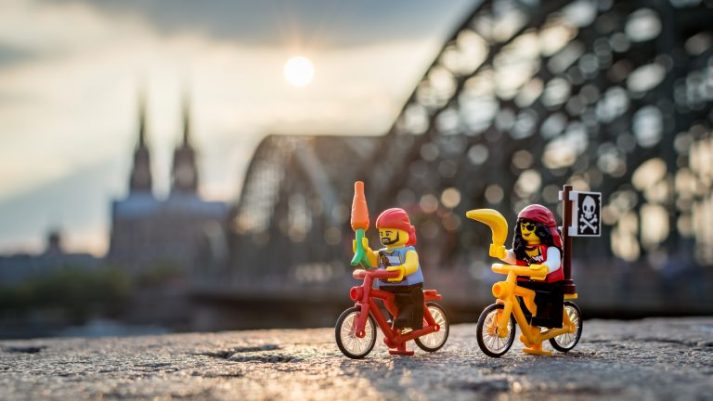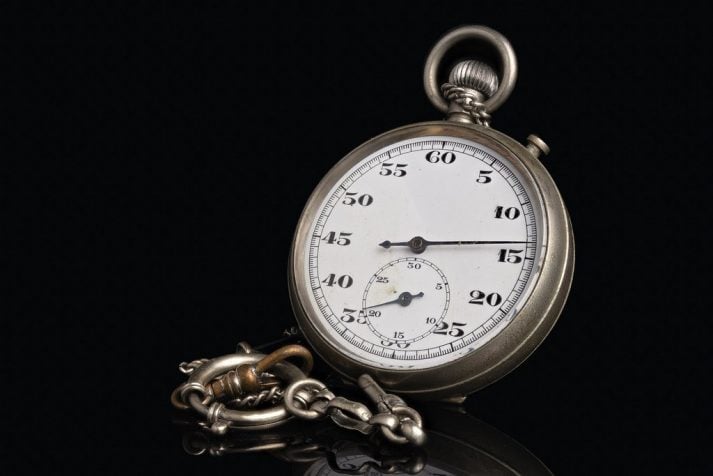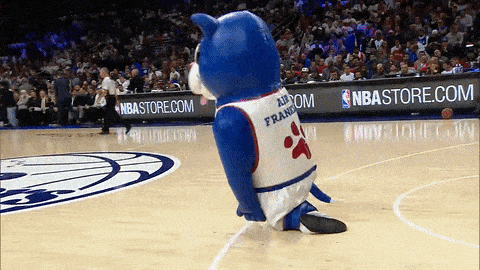on
Verdure
- Get link
- X
- Other Apps

This High-Intensity Interval Training (HIIT) guide is probably the best interval training guide in the galaxy.
My justification for such a bold claim?
We’re really good at this stuff, AND we have dinosaurs and Muppets.
Plus, lots of great gifs:

We build custom interval training programs just like the ones in this guide for our 1-on-1 Online Coaching Clients, including workouts for at home, the gym, or even while traveling.
In this Ultimate Guide to Interval Training, we’ll cover:
If you’re interested in starting a HIIT practice (which you are, ’cause you’re here), you may want to try our new app! It contains a fun adventure that will take you from sitting on your couch to a full HIIT workout – with plenty of benchmarks in between for you to find your groove. No guesswork needed, just jump into the app and follow it’s next steps.
You can sign-up for a free trial right here:

In 2018, High-Intensity Interval Training (HIIT) was ranked the number one fitness trend by American College of Sports Medicine.[1]
Essentially, HIIT is just following a specific regimen where you vary your speeds and intensity throughout a shorter run, swim, bike, or row.
Any exercise can be a form of HIIT, but here’s a common routine:
Because everybody is busy and overwhelmed, fast results in the least amount of time leads to most people discovering HIIT.

You may be asking, “Steve, just how short and intense are we talking about here? Also, your new haircut looks spiffy.”
Thank you, you’re very kind.
So let’s explore the pros and cons of intervals.

The 1996 landmark Tabata study demonstrated the benefits of extreme HIIT.[2]
Dr. Izumi Tabata, from Japan’s National Institute of Fitness and Sports, was obsessed with interval training.
The doctor sought to see exactly what kind of gains were obtained from short, intense, periods of exercise. He conducted an experiment with Olympic athletes on stationary bikes and put them through intense bouts of exercise followed by short periods of rest.
The results were fascinating.
Compared to regular cardio, HIIT had a greater impact on improving BOTH:
Even crazier? Tabata was able to demonstrate improvements in his athletes with just four minute bursts.
So what’s happening here?
Simple: your heart is a muscle.

If you keep your heart beating at a constant rate, never expanding it outside of its comfort zone, it will never grow stronger.
By introducing chaos and pushing your muscles outside of their comfort zone, they must adapt and grow more resilient in order to survive.
Intense interval training challenges your heart by constantly forcing it outside of its comfort zone.
In other words: progressive overload – the same concept behind building strength.
Since Tabata’s 1996 study, many other trials have shown the positive impact of interval training.
Here are some of the benefits of High-Intensity Interval Training:
#1) HIIT for Weight loss. A study in the Journal of Obesity found participants were able to lose more body fat following a HIIT program compared to regular cardio.[3]
This makes sense, because other studies suggest high-intensity interval training burns more calories than a “steady state” workout.[4]
Revving up your effort requires more out of you, including calories. If you’re interested in HIIT for weight loss, you might be on the right track.

Plus, interval training can take less time than steady-state cardio.
The average interval training workout is 20 minutes or less.
However, I should note that a meta-study (a review of multiple studies) found no real difference in fat loss between HIIT and steady-state cardio.[5] We’ll talk about this, and the impact of diet for weight loss later.
#2) HIIT for lowering blood sugar. Managing blood sugar is really important for health, not just for diabetics.
Those trying to lose fat should be aware of their blood sugar and corresponding insulin levels.
The good news for our current discussion? HIIT has been shown to help lower and manage blood sugar levels.[6]
#3) HIIT for heart health. Touching on the “antifragile” topic again, HIIT has been shown to help with overall cardiovascular health.
It does so in the same way traditional endurance training does, but at a fraction of the time (almost half).[7]
Now, before you accuse me of being a shill for Big HIIT, I will mention that many of the comments that “HIIT is the secret to fat loss” are overblown.[8]We’ll touch on more of that later.
For now, let’s chat about how to actually do some interval training.

The key to HIIT is being able to go from “easy” to “difficult.” All sorts of different exercises can get you there:
HIIT is generally associated with running (aerobic), so we’ll devote this section to just that.
The easiest way to experiment with HIIT would be to run.
Here’s how to start with a basic HIIT running workout. Go to a park in your neighborhood. Warm-up with some light jogging, high knees, and mobility – leg swings, arm swings, etc,
And then begin your workout!
And BAM! You just did HIIT.
Don’t get disheartened if you find yourself stopping a lot during your first week of HIIT training.

You’ll be surprised how quickly you get better at this!
Also, “running” or “jogging” is subjective. Whatever walking fast means to you is great. Do that for your periods of intensity.
It should be noted, that the entire “Couch to 5K” concept rests on interval training through running.
It’s all broken down into “walking,” “jogging” and “running.”
If you’re curious, check out our in-depth Couch to 5k review. If you want to start interval training, “Couch to 5K” could be a good way to do it.
More of an indoor person?
Consider a treadmill, where it actually sets intervals for you based on your desired difficulty.
Just be careful on it…

We’ll be talking about machines a lot more in the next section, but a treadmill is all you need to do a HIIT workout.
Experiment with the speed and incline to find a setting that you would consider “intense.” Many machines can be programmed to flip between this and an “easy” setting.
And you know what that means… boom! It’s built for HIIT.
When we designed NF Journey, we used this “intense” and “easy” interval switch for much of the workouts within the app.
If you want, you can sign-up for a free trial right here to see what I mean:

There are a lot of different aerobic exercises for HIIT cardio.
For example, you could jump on a bike, which is like HIIT running but with wheels (duh):

Every spin class is based on HIIT cycling (SoulCycle, Flywheel, or even your local gym now has spin classes).
They’re popular for a reason, and you can make a friend or two!
Here are some more examples of interval training:

So far we’ve just been talking about aerobic exercises.
Let’s cover our other categories, of bodyweight and resistance.

“Steve, this all sounds great. But I hate running!”
Confession: So do I.
So I get my cardio in other forms!
Here are some bodyweight exercises to get going on HIIT:
Let’s now chat some Weight Training Examples for HIIT:
You can also do circuit training as a form of HIIT.
Circuit training is going through a sequence of exercises, or stations, back to back.
Push-ups to pull-ups, back to push-ups, only resting briefly from one exercise to another.
Circuit training would be perfect to mix into a HIIT workout, since you can design your circuit to be very intense.
Check out our post for 15 Circuit Training Routines to choose from.
Plus, there’s a Batman workout hidden in there. You’re welcome.
We create custom HIIT programs for busy people like you that are ACTUALLY fun. If you’re looking for a supportive coach to guide you and tell you exactly what to do each day, we got you covered!
If you just want a beginner circuit to get started with, you can try out our Beginner Bodyweight Workout Routine. Plus you can download a free worksheet to track your progress with this circuit when you join the Rebellion below:
Oh, what’s that? You want to have even MORE fun while getting the benefits of HIIT? Let’s think outside the box:

Basketball, tennis, soccer, and Ultimate (frisbee) are AMAZING styles of exercise that use interval training (it’s all start and stop!).
Run here, catch this, and wait for the next round to start.
That’s what we’re looking for in a HIIT workout.
So pick a form of FUN exercise that gets your heart racing faster and slower throughout the activity (yes, I suppose even THAT activity would count).

My guess is that you’re reading this article because you’re trying to get the most efficient “bang for your buck” when it comes to getting in shape.
And HIIT is a great form of exercise and COULD help with weight loss.
I will, however, lower some of these outlandish claims that exist in the media.
For example, Time magazine calls HIIT “miraculous” in one article.[9]
That’s a little much, even for me, who writes for a living on why you should work out and likes using hyperbole for effect.
Seriously, I’m better at it than ANYBODY ON THE PLANET.
Ahem.
Cardio, strength training, and HIIT all have many benefits.
HIIT deserves praise, but exercise in general deserves praise. As we discussed in our “Cardio vs HIIT vs Weights” post, all three forms of training have their place, and the best one for you is the one you actually do.
And strength training. Always strength training.

So to answer your question, is HIIT the secret and only weapon for weight loss?
Nah, it’s just great exercise.
And exercise is important.
But if you want to lose body fat, how you eat will be responsible for 80% of your success or failure.
This means that I don’t care how many intervals you do, it’s not gonna help you lose weight if you don’t also fix your nutrition.
You can read our Beginner’s Guide to Nutrition if you want more information.
And if you want to download our free 10-level Nutrition Guide to help you fix your diet starting today, you can do so by signing up in the box below:

When it’s time to advance your high-intensity interval training, think about the following:
Maybe you start out doing 3 intervals of intense running.
Once it becomes routine, bring it up to 4.
Maybe you crank the resistance on your stationary bike to “8” during your intense interval. When it becomes normal, bring it up to “10.”
Maybe you do pull-ups for 20 seconds. When you’ve got a good handle on that, aim for 30 seconds.
This mindset will keep you advancing in interval training.
Consistency is the name of the game. Even just doing a HIIT workout once a week will help you progress in all three categories.

There’s a lot to consider when embarking on a HIIT practice.
No matter which routine you end up starting with, make sure you follow these words of wisdom:
Take it easy, focus on your form, and make sure to prioritize rest.

HIIT centers on doing intervals.
One moment it’s intense, the next you’re onto a short rest break.
A good way to know when it’s time to go from one sequence to the next is a timer. A loud “beep” can tell you when it’s okay to catch your breath or when you have to kick it in gear.
Here are 5 HIIT timers you can try out:
Also, we need to talk about interval timers. Most of the apps referenced are completely customizable.
For example, you can change the intense interval from 120 seconds to 90 seconds.
This is critical because it’s up to you to decide how long you can do intense vs. rest.
Generally, folks recommend one minute of intensity and then two for rest when doing HIIT.
However, this all depends on the individual, and exercises performed.
For example, burpees are tougher to do than jumping over a rope:

So feel free to make changes like 30 seconds of intensity and three minutes of rest. Make it your own.
Whatever way you chose to do HIIT, is fine, as long as you actually do it. The benefits of HIIT kick in when going HARD for you.
In other words, you don’t have to be an Olympic athlete to get the benefits of HIIT.[10]
A light jog totally works. Just don’t do it in a mascot costume.

As we discussed, if you’re consistent, you’ll improve.
So don’t stress about where you have to start.
For now, download an app and get going.

Let’s power walk as our form of HIIT.
This is an example of a beginner HIIT workout we might prescribe for our Coaching Clients who are starting to train for their first 5K.
Let’s do seven intervals, two minutes each:
Total time: 20 minutes.
I want to stress, that you can do just about any exercise in exchange for this routine. Just minus “power walk” and add “push-ups and bodyweight squats”
It’ll still be a great HIIT workout.
“But Steve, that’s still multiple choice!”
Right, right… sorry. Stick to power walking! Done!

Do our power walking routine above. It’s a great place to start.
Remember, our goal at this stage is “build the habit.”
We can work on “whoa, that was intense” later.
If you’re looking for EVEN MORE stuff to do, we have a few options for ya:
1) Check out our popular 1-on-1 coaching program. You’ll work with our certified NF instructors who will get to know you better than you know yourself and program your workouts and nutrition for you.
2) Exercising at home and need a plan to follow? Check out Nerd Fitness Journey!
Our fun habit-building app helps you exercise more frequently, eat healthier, and level up your life (literally).
Try your free trial right here:
3) Enlist in the Rebellion! We need good people like you in our community, the Nerd Fitness Rebellion.
Sign up in the box below to enlist and get our guide, Strength Training 101: Everything You Need to Know. It’ll help you start incorporating interval training into your workouts.
There are a zillion ways to do HIIT, so don’t let the options paralyze you.
Pick one, any one, and get to it.
Interval training, in any form, is a solid fitness choice and a great practice to have in the workout arsenal.
Any questions?
Which HIIT workout style is your favorite?
Leave it in the comments below!
-Steve
PS: Make sure you check out the rest of our content on interval training:
###
All photo credits can be found in this footnote.[10]
Comments
Post a Comment